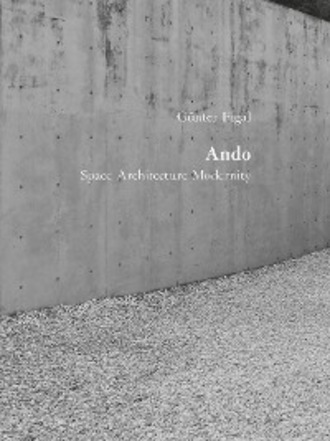
Полная версия
Günter Figal - Ando
Because Ando is primarily interested in space, and not so much in the visible form and the material of a building he – unlike his predecessors Wright and Le Corbusier – has presumably not been bound to experiments in a wide spectrum of styles and with a broad range of different materials. From its very beginning, his architecture has been restricted to a few clearly defined elements. These, however, are applied so flexibly and with such diversity that Ando has been able to realise a rich assortment of architectural possibilities. These elements are so characteristic that a building of Ando’s is almost always instantly recognizable: concrete elements, devoid of allusion to ‘brutalism’, as if the buildings were ramparts, but light in appearance, with surfaces like marble; interiors often, like the exterior walls, without render, in proportions adopted from traditional tatami mats, and typically marked with six bolt holes. In addition to concrete, Ando’s materials of choice are glass and metal, the latter generally painted in pale matt grey, on occasion light-coloured quarried stone, while wood often also finds a welcome. Some roofs are covered with vegetation, and so blend into the landscape. Paths and forecourts are often – as in Zen gardens – surfaced with gravel, while time and again, expanses of water serve as partial surroundings or even integral parts of Ando’s buildings. The structures of Ando’s buildings are also characteristic. They consist mostly of several clearly distinct elements –often protruding wings or cubes that meet at sharp or obtuse angles, sometimes in layers, and combined with rotundas and patios. Again and again, there are freestanding walls, some of them forming courtyards, though mainly functioning to extend a building into its surroundings, but also to demarcate it from them. Open frame constructions complementing a building with airy volumes function in a similar way. As Ando stresses, his buildings – like those of traditional Japanese architecture or the Venetian architect Carlo Scarpa he admires – “originate from the part,” whereas, “Western architec -ture reflects the philosophy of a logically assembled composition or totality.” As Ando explains, from “the parts comes form, and while these parts or elements are completely self-sustaining and remain on the verge of separation, they mysteriously maintain balance as a whole.”[4]
In Ando’s buildings, the discreteness of their parts is often derived from their visual complexity. It is nearly impossible to view these buildings at a glance, not at least because they are usually horizontal in structure; even when they are larger, they tend to be flat, stretched out along level planes or stretching uphill. In many cases, they are more building-landscapes than looming structures, and thus comparable to gardens. Like gardens not intended for visual contemplation only, it is best to explore them on foot. And by taking them in, without having to find words, one will experience space through built rooms. Repeating the experience in a variety of buildings will lead to one becoming more and more attentive to what is to be experienced. One will begin reflecting and pondering retrospectively on what has been experienced. One will remember details, possibly supported by photographs taken in and around the buildings. One will thus eventually find words to describe these experiences and what has been encountered.

Benesse House Museum

Yumebutai-Complex

Yumebutai-Complex

Himeji City Museum of Literature

Himeji City Museum of Literature

Himeji City Museum of Literature

Himeji City Museum of Literature

Yamaguchi-Haus

Yamaguchi-Haus

Vitra Konferenzpavillon

Vitra Konferenzpavillon

Vitra Konferenzpavillon

Vitra Konferenzpavillon

Way to the Nishida Kitarô Museum of Philosophy

Nishida Kitarô Museum of Philosophy

Himeji City Museum of Literature
Contemplating while Walking
Entering Ando’s buildings on foot in a contemplative frame of mind, it is soon to be discovered that these structures are dominated by their ways, which cannot be tread without thought, merely to get from one room to another. Frequently, the ways do more than just lead somewhere, they are intended to be conspicuous as what they are. At times they are generous and wide, at others narrow, sometimes they are flat and even, sometimes steep; sometimes their meandering nature makes it difficult to see where they might lead. There are a great deal and variety of ways: ramps and overpasses, stairs, galleries, and winding ways along walls, as well as labyrinth-like ways that offer doubtful alternatives of where to go.
In Ando’s buildings, there are certainly also normal ways, inconspicuous passages, from room to room. The others, however, are more important because through them, the architecture of the building can be experienced. Treading these, the conspicuous ones, one is able to see the building they belong to appearing in constantly different perspectives, revealing the building as it is in itself. One such passage is the long, flat ramp in the Benesse House Museum on the island of Naoshima, which connects the two floors of the building. Stepping onto this ramp, the elongated and bright room it belongs to stretches out in two directions. The generous gradients of the ramp ensure an unhurried pace that allows the room to be viewed and its artworks beheld, as if in slow motion, especially two large works by Frank Stella, The Grand Armada and The Shark Massacre. In the Langen Foundation, close to Düsseldorf, a similar ramp leads unhurriedly alongside the works of art on display. Likewise, one would traverse the ramps in the Yumebutai complex on Awaji Island (Awajishima), or in the Himeji Museum of Literature. In either case, ways guide one through Ando’s garden of architecture, where, again and again, one might feel persuaded to take a path other than the one intended, until one would eventually no longer have any specific intentions and, in walking, would simply contemplate the garden of architecture. Such contemplation can also take place at smaller houses, for instance, the duplex in Takarazuka. Here, Ando designed a ramp for the street side of the house that looks quite similar to the ramps of the two museums just mentioned. The ramp opens up the austere and windowless façade and transforms it into a small building-landscape. Before leading into the house, it offers an elevated pathway along the house, and allows a panoramic view over the steep street downhill and out to Osaka Bay. The house is a very early example of Ando’s work. It shows that installations for the experience of wideness, such as the described ramps, have been an integral part of Ando’s architecture as a whole, and not just reserved to buildings intended for contemplation. Also, the courtyard of Ando’s row house in Sumiyoshi, a suburb of Osaka, features a gallery, which acts in a similar way to the ramps. One has to take this gallery in order to get from one of the two rooms on the upper floor to the other. Ways that reveal space belong to the basic forms of Ando’s architecture. They also allow his smaller buildings to expand.
However, there are also other elements in Ando’s architecture that allow the beholder to focus and become tranquil. The path leading to the conference pavilion on Vitra Campus in Weil am Rhein is so narrow that if a larger number of people were to make their way along it at once, they could only do so in single file and cease conversation. The path leads circuitously to the building without allowing sight of the entrance. It leads around a concrete wall that, only when reached, reveals itself as a freestanding wall. Following this wall and then becoming even narrower, the path leads to the entrance door that, because of its narrowness, cannot be entered through without attention. Entering the building, one really feels that one has made an entrance. The way to the entrance is not direct, and thus not the shortest route. In terms of efficiency, it is far too long, just like the way leading to the Nishida Kitarô Museum of Philosophy
Конец ознакомительного фрагмента.
Текст предоставлен ООО «Литрес».
Прочитайте эту книгу целиком, купив полную легальную версию на Литрес.
Безопасно оплатить книгу можно банковской картой Visa, MasterCard, Maestro, со счета мобильного телефона, с платежного терминала, в салоне МТС или Связной, через PayPal, WebMoney, Яндекс.Деньги, QIWI Кошелек, бонусными картами или другим удобным Вам способом.
Примечания
1
Michel Foucault, Des espaces autres, in: Michel Foucault, Dits et ecrits, edited by Daniel Defert and Francois Ewald, Paris 1994, volume IV, 752-762.
2
Cf. Günter Figal. Unscheinbarkeit. Der Raum der Phänomenologie, Tübingen 2015.
3
Frank Lloyd Wright, The Natural House, in: Bruce Brooks Pfeiffer (ed.), The Essential Frank Lloyd Wright. Critical Writings on Architecture, Princeton / Oxford 2008, 319-364.
4
Tadao Ando, Conversations with Students, translated and edited by Matthew Hunter, New York 2012, 20, 69.



